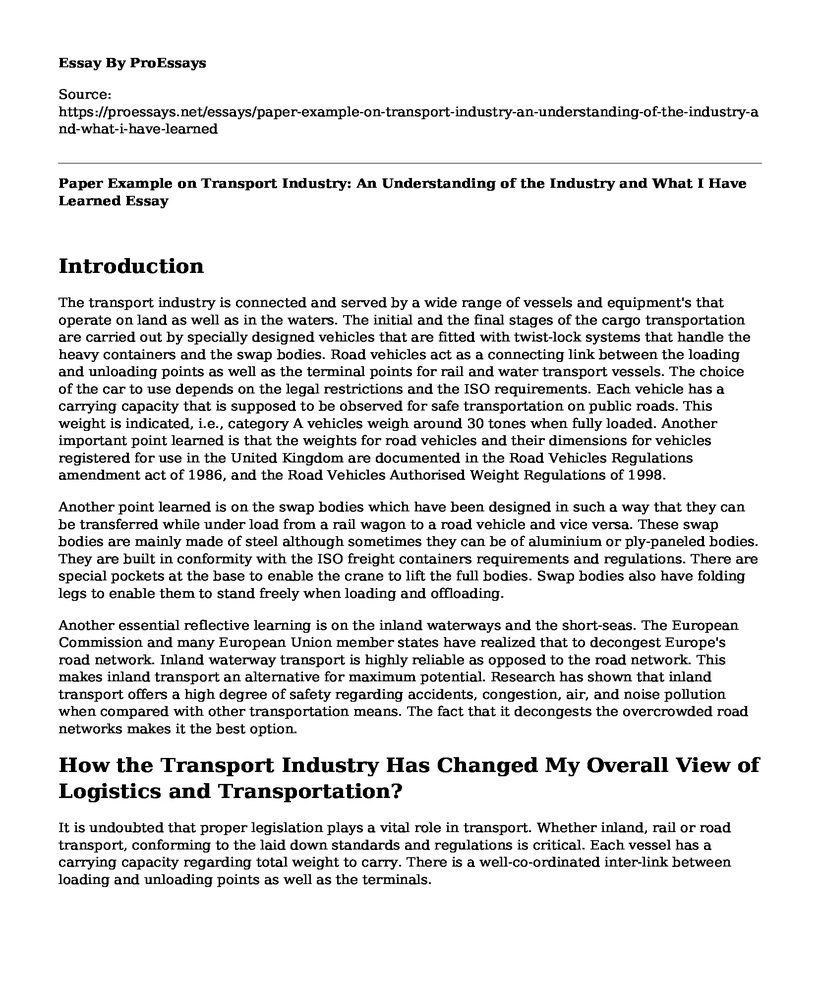Introduction
The transport industry is connected and served by a wide range of vessels and equipment's that operate on land as well as in the waters. The initial and the final stages of the cargo transportation are carried out by specially designed vehicles that are fitted with twist-lock systems that handle the heavy containers and the swap bodies. Road vehicles act as a connecting link between the loading and unloading points as well as the terminal points for rail and water transport vessels. The choice of the car to use depends on the legal restrictions and the ISO requirements. Each vehicle has a carrying capacity that is supposed to be observed for safe transportation on public roads. This weight is indicated, i.e., category A vehicles weigh around 30 tones when fully loaded. Another important point learned is that the weights for road vehicles and their dimensions for vehicles registered for use in the United Kingdom are documented in the Road Vehicles Regulations amendment act of 1986, and the Road Vehicles Authorised Weight Regulations of 1998.
Another point learned is on the swap bodies which have been designed in such a way that they can be transferred while under load from a rail wagon to a road vehicle and vice versa. These swap bodies are mainly made of steel although sometimes they can be of aluminium or ply-paneled bodies. They are built in conformity with the ISO freight containers requirements and regulations. There are special pockets at the base to enable the crane to lift the full bodies. Swap bodies also have folding legs to enable them to stand freely when loading and offloading.
Another essential reflective learning is on the inland waterways and the short-seas. The European Commission and many European Union member states have realized that to decongest Europe's road network. Inland waterway transport is highly reliable as opposed to the road network. This makes inland transport an alternative for maximum potential. Research has shown that inland transport offers a high degree of safety regarding accidents, congestion, air, and noise pollution when compared with other transportation means. The fact that it decongests the overcrowded road networks makes it the best option.
How the Transport Industry Has Changed My Overall View of Logistics and Transportation?
It is undoubted that proper legislation plays a vital role in transport. Whether inland, rail or road transport, conforming to the laid down standards and regulations is critical. Each vessel has a carrying capacity regarding total weight to carry. There is a well-co-ordinated inter-link between loading and unloading points as well as the terminals.
Lessons to Take for My Job Tomorrow and in the Future
There is real potential in the inland waterways that when fully exploited, more efficiency and less pollution will be achieved. There is also need to decongest already crowded reads transport networks by investing more in inland waterways. Lastly, laws and regulations need to be followed to achieve maximum benefits from the transport industry.
Cite this page
Paper Example on Transport Industry: An Understanding of the Industry and What I Have Learned. (2022, May 16). Retrieved from https://proessays.net/essays/paper-example-on-transport-industry-an-understanding-of-the-industry-and-what-i-have-learned
If you are the original author of this essay and no longer wish to have it published on the ProEssays website, please click below to request its removal:
- How Do Hispanic People Experience Equality in Their Workplace? - Research Paper
- Statement of Ethics Paper Example
- Correction Officers Career Analysis Paper Example
- New Safety Program Paper Example
- Essay Sample on Conflict Resolution: Restorative Approaches for Young Children
- Motivation in Business: Internal & External Factors for Entrepreneurial Success - Essay Sample
- Police Force: Essential for Law Enforcement and Order in a Country - Essay Sample







